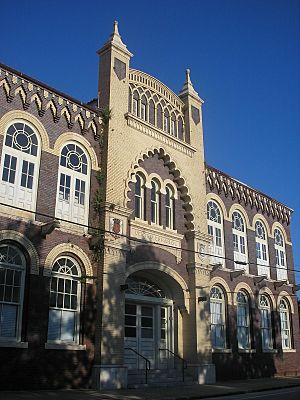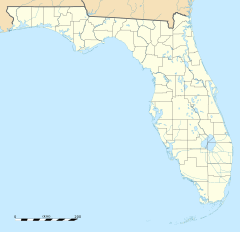West Tampa facts for kids
Quick facts for kids
West Tampa
|
||
|---|---|---|
|
District
|
||
|
||
| Country | United States | |
| State | Florida | |
| County | Hillsborough | |
| City | Tampa | |
| Time zone | UTC-5 (Eastern (EST)) | |
| • Summer (DST) | UTC-4 (EDT) | |
| Area code(s) | 813 | |
West Tampa is one of the oldest neighborhoods in Tampa, Florida. It was its own city from 1895 until 1925. Then, it became part of Tampa. West Tampa is located west of the Hillsborough River, about one mile from downtown.
In 2000, about 22,008 people lived there. Since it was founded in 1892, West Tampa has been home to many Latino families.
Contents
West Tampa's Story
How West Tampa Started
West Tampa was created in 1892 by a man named Hugh Macfarlane. He was an immigrant from Scotland and a local lawyer. Macfarlane bought 200 acres of land. He wanted to build a new community there. He hoped to attract cigar factories and workers from Ybor City. Ybor City was another successful immigrant community in Tampa.
At first, West Tampa didn't grow very fast. Getting there was a problem. The first cigar factory had to close for a short time. Workers didn't want to take a ferry across the Hillsborough River to West Tampa.
By 1894, Macfarlane had built a bridge. He also connected West Tampa to Tampa's streetcar system. This helped West Tampa grow a lot. Many new people moved in. Most were Cuban immigrants who came to the United States. So, West Tampa was mostly Cuban in its early years. Later, more Italians and Spaniards moved in, often from Ybor City. This made the two communities more alike over time.
West Tampa officially became a city in 1895. It had 2,335 people, making it the second-largest Hispanic community in Florida. By 1900, it had more people than Florida's capital, Tallahassee. It was also the second-largest city in Hillsborough County, after Tampa. In the early 1900s, West Tampa and Ybor City together made more hand-rolled cigars than anywhere else. This earned Tampa the nickname "Cigar City."
The first public library in Hillsborough County opened in West Tampa in 1914. It was called the West Tampa Free Public Library. The money for the building came from a grant by Andrew Carnegie. The library was fixed up and made bigger in 2004. It is still used today.
West Tampa Police Department
While it was its own city, West Tampa had its own police department. It joined the Tampa Police Department in 1925. One officer lost his life during its history. On July 18, 1920, Patrolman Juan Nales was with another officer. They were taking a person they had arrested to jail. The person attacked them and took Nales's gun. Officer Nales was shot and died. The person was caught and later found guilty.
Becoming Part of Tampa
Over the years, West Tampa and Ybor City became very connected. Many "Latins" (as people from Spanish, Cuban, and Italian backgrounds were called in Tampa) had family and friends in both towns. People often lived in one place and worked in the other. Social clubs from Ybor City often held big events at West Tampa's MacFarlane Park. Some clubs even built special branches in West Tampa for their members. This made the two areas feel even more like one community.

The lines between West Tampa and "Anglo Tampa" also started to blur. Tampa grew bigger, and its suburbs reached West Tampa's edges. In 1925, West Tampa officially became part of the city of Tampa.
West Tampa Today
After World War II, Ybor City became less busy. Many of its residents moved to West Tampa. This made West Tampa the biggest neighborhood with a large Latin population. The cigar industry in West Tampa also faced problems. But West Tampa had other businesses, so it survived.
In the late 1950s and early 1960s, many more Cuban immigrants came to West Tampa. They were leaving Castro's revolution. By then, there were not many jobs left in cigar factories. So, new arrivals found work in other areas.
Today, West Tampa has many Colombian cuisine and small Cuban and Puerto Rican restaurants. You can also find ethnic markets. These are mostly along main roads like Columbus Drive, Armenia Avenue, Howard Avenue, Main Street, and Tampa Bay Boulevard. Most of the old brick cigar factory buildings are still standing. But they are not used for making cigars anymore. Some have been fixed up for offices. Others have been empty for years. A few cigars are still rolled in smaller shops.
West Tampa has faced challenges like poverty since the 1970s. But people are now showing more interest in its history and culture. Since the 2000s, there has been more investment and new building projects. This slowed down during the 2008 recession. But it started again later. New apartments have been built. Julian Lane Waterfront Park was renovated. Older public housing has been replaced with new townhomes.
Where is West Tampa?
The historical borders of West Tampa are the Hillsborough River and Rome Avenue to the east. To the north is Dr. Martin Luther King Jr. Blvd (which used to be Buffalo Ave.). To the south is Kennedy Blvd. (formerly Grand Central Ave.). To the west is Dale Mabry Highway. Much of this area is part of the West Tampa Historic District. Interstate 275, built in the 1960s, runs through the middle of the neighborhood. The area is about 10 square miles (26 square kilometers).
Parts of West Tampa
Within the West Tampa district, there are smaller areas. These include Bowman Heights, Marina Club, Northeast Macfarlane, and Old West Tampa.




